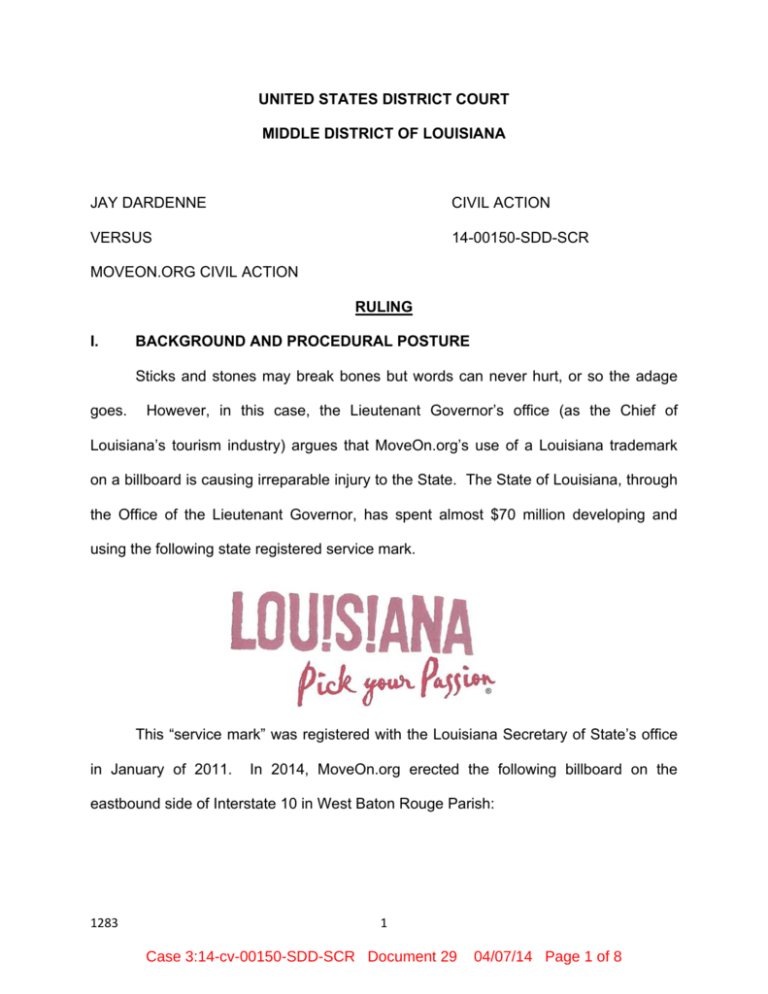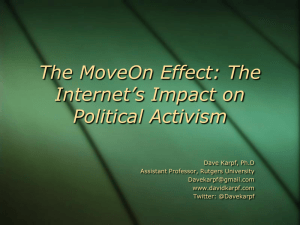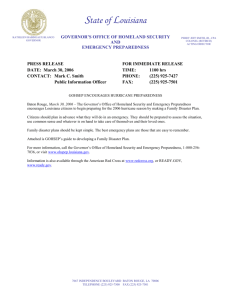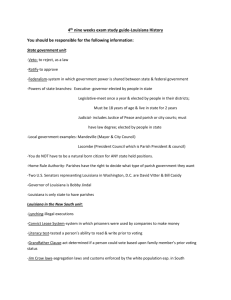Dardenne v. MoveOn.org
advertisement

UNITED STATES DISTRICT COURT MIDDLE DISTRICT OF LOUISIANA JAY DARDENNE CIVIL ACTION VERSUS 14-00150-SDD-SCR MOVEON.ORG CIVIL ACTION RULING I. BACKGROUND AND PROCEDURAL POSTURE Sticks and stones may break bones but words can never hurt, or so the adage goes. However, in this case, the Lieutenant Governor’s office (as the Chief of Louisiana’s tourism industry) argues that MoveOn.org’s use of a Louisiana trademark on a billboard is causing irreparable injury to the State. The State of Louisiana, through the Office of the Lieutenant Governor, has spent almost $70 million developing and using the following state registered service mark. This “service mark” was registered with the Louisiana Secretary of State’s office in January of 2011. In 2014, MoveOn.org erected the following billboard on the eastbound side of Interstate 10 in West Baton Rouge Parish: 1283 1 Case 3:14-cv-00150-SDD-SCR Document 29 04/07/14 Page 1 of 8 The State, through its Motion for Preliminary Injunction1, asks this Court to compel MoveOn.org to immediately remove the billboard and prohibit MoveOn.org from using Louisiana’s service mark in any other advertising or media. On the one hand is the State’s claim of trademark infringement, on the other is MoveOn.org’s right to free speech. The subject Billboard is critical of the State’s health care policies.2 MoveOn.org has a First Amendment Constitutional Right to criticize the State with respect to any of its public policies, including its health care policies. The issue is whether MoveOn.org may use the State’s registered service mark as part of its means and manner of criticizing the State or the Governor. As observed by the United States Supreme Court, “[s]peech is an essential mechanism of democracy, [for] it is the means to hold officials accountable to the people.”3 “The right of citizens to inquire, to hear, to speak, and to use information to reach consensus is a precondition to an enlightened self-government and a necessary 1 Rec. Doc. 2. The subject billboard is actually critical of Governor Bobby Jindal, but Jindal is the Chief policy maker for the State. 3 Citizens United v. Federal Election Commission, 558 U.S. 310, 312 (2010). 2 1283 2 Case 3:14-cv-00150-SDD-SCR Document 29 04/07/14 Page 2 of 8 means to protect it.”4 For these reasons, “political speech must prevail against laws that would suppress it, whether by design or inadvertence.”5 The United States Supreme Court has held that laws which burden political speech are “subject to strict scrutiny” requiring the government to prove that the “restriction ‘furthers a compelling interest and is narrowly tailored to achieve that interest’.”6 Thus, the question before this Court is: Does the enforcement of trademark laws7 burden MoveOn.org’s constitutional right to free political speech. If so, the state must demonstrate that its interest in protecting its service mark from unauthorized use by MoveOn.org is compelling and that the injunctive relief sought is narrowly tailored to achieve that interest. A preliminary injunction is an extraordinary remedy that may be used only upon a clear showing of the substantial likelihood of success on the merits and irreparable injury. Not only must the State demonstrate a likelihood of success on the merits and a likelihood of irreparable harm, the State must also show that the balance of equities tips in its favor and that an injunction is in the public’s best interest.8 At that outset, the Court notes that the people of Louisiana have an interest in protecting the propriety of their service mark; but, is that interest so compelling as to require that MoveOn.org be prohibited from using it as a parody to criticize the State’s healthcare policies? II. TRADEMARKS GENERALLY “A trademark is a word, phrase or symbol that is used to identify a manufacturer or sponsor of a good or provider of a service. It’s the owners’ way of preventing others 4 Id. at 339. Id. 6 Id. citing Federal Election Com’n v. Wisconsin Right to Life, Inc., 551 U.S. 449, 464 (2007). 7 15 U.S.C. § 1114 and La. R.S. § 51:222. 8 Winter v. Natural Resources Defense Council, Inc., 555 U.S. 7 (2008). 5 1283 3 Case 3:14-cv-00150-SDD-SCR Document 29 04/07/14 Page 3 of 8 from duping consumers into buying a product they mistakenly believe is sponsored by the trademark owner.”9 Thus, the main purpose of trademark laws is to “secure the owner of the trademark the good will of his business and to protect the ability of consumers to distinguish among competing products.”10 The goal of the federal trademark law, upon which the State’s trademark law is patterned, is to protect from unfair trade competition. That is, to protect from counterfeits, copies, and colorable imitations of registered marks.11 In short, claims of trademark infringement are intended “to protect persons engaged in… commerce against unfair competition.”12 To prevail on a trademark infringement claim the State must show two things. First, the State must establish ownership and a legally protectable mark and, second, the State must show infringement by demonstrating that the unauthorized use of the mark creates a likelihood of confusion in the minds of the consumer.13 Likelihood of confusion is synonymous with a probability of confusion, which is more than a mere possibility of confusion.14 A determination of a likelihood of confusion under federal law is the same as the determination of a likelihood of confusion under Louisiana law for a trademark infringement claim.15 Louisiana is using its service mark to encourage and promote tourism, a form of commerce. The Parties do not dispute that the State has a legally protectable mark. The critical issue is whether MoveOn.org’s use of the State’s service mark “creates a 9 Mattel, Inc. v. MCA Records, Inc., 296 F.3d 894, 900 (9th Cir. 2002)(internal citations omitted). Eppendorf-Netheler-Hinz GMBH v. Ritter GMBH, 289 F.3d 351, 355 (5th Cir. 2002). 11 15 U.S.C. § 1114(1)(b). 12 Two Pesos, Inc. v. Taco Cabana, Inc., 505 U.S. 763, 767-68 (1992). 13 Board of Supervisors for Louisiana State University v. Smack Apparel Company, 550 F.3d 465, 474 (5th Cir. 2008); Amazing Spaces, Inc. v. Metro Mini Storage, 608 F.3d 225, 235-236 (5th Cir. 2010). 14 Elvis Presley Enters. v. Capece, 141 F.3d 188, 193 (5th Cir. 1998). 15 Blue Bell Bio–Med. v. Cin–Bad, Inc., 864 F.2d 1253, 1260 (5th Cir.1989); see also 3 J. Thomas McCarthy, McCarthy on Trademarks and Unfair Competition § 23:3 (4th ed.1997). 10 1283 4 Case 3:14-cv-00150-SDD-SCR Document 29 04/07/14 Page 4 of 8 probability of confusion in the minds of the viewers of the billboard as to the ‘source, affiliation or sponsorship’ of the message.” The burden of proving infringement is on the State and, in this preliminary injunction context, the State must demonstrate that it is substantially likely to prove at a subsequent trial on the merits that MoveOn.org’s use of the State’s service mark creates a probability of confusion in the minds of the viewers of the billboard. III. THE FIRST AMENDMENT This case “involves the tension between the protection afforded by the Lanham Act to trademark owners and the protection afforded by the First Amendment to expressive activity.”16 “When the unauthorized use of another’s mark is part of a communicative message and not a source identifier, the First Amendment is implicated in opposition to the trademark.”17 “[T]rade rights do not entitle the owner to quash an unauthorized use of the mark by another who is communicating ideas or expressing points of view.”18 While the “First Amendment may offer little protection for a competitor who labels its commercial good with a confusingly similar mark,”19 the First Amendment is implicated when a trademark is used by someone other than the mark owner for the purposes of “communicating ideas or expressing points of view”.20 MoveOn.org contends that it used Louisiana’s service mark as a parody to express a political point of view. MoveOn.org argues that it is employing parody21 by poking fun at the State’s logo and slogan in order to criticize the State. According to 16 Westchester Media v. PRL USA Holdings, Inc., 214 F.3d 658, 664 (5th Cir. 2000). Mattel, 296 F.3d at 901. 18 L.L.Bean, Inc. v. Drake Publishers, Inc., 811 F.2d 26, 29 (1st Cir. 1987), citing Lucasfilm Ltd. v. High Frontier, 622 F.Supp. 931, 933-35 (D.C.D.C. 1985). 19 Mattel, 296 F.3d at 900. 20 Id. , quoting L.L.Bean, 811 F.2d at 29. 21 Parody is an artistic work or message that uses at part of its composition, the mark of another to ridicule the author of that mark. Campbell v. Acuff-Rose Music, 510 U.S. 569, 580 (1994). 17 1283 5 Case 3:14-cv-00150-SDD-SCR Document 29 04/07/14 Page 5 of 8 MoveOn.org, its “intent was to communicate… the message that, whereas the Louisiana tourism campaign is promoting the State as a desirable place to visit, the State might be considered an undesirable place to visit because of its [health care policies]”.22 It is clear to the Court that MoveOn.org did not use Louisiana’s service mark for the purpose of gaining attention to products and services associated with mark, but as a parody for the purpose of expressing an idea, opinion, or criticism. However, parody does not provide an absolute cloak of protection from a claim of trademark infringement claim. Parody notwithstanding, if reader confusion is likely, an action for trademark infringement lies. The State argues that viewers of the billboard will be confused into thinking that the Lieutenant Governor, as the alleged owner of the service mark, is being critical of the Governor. In this Court’s view, the Lieutenant Governor underestimates the intelligence and reasonableness of people viewing the billboard. The State’s argument that viewers of the billboard may be confused into believing that the Lieutenant Governor is criticizing the Governor is strained. First, viewers would have to know that the service mark in question is a creation of and sponsored by the Lieutenant Governor’s Office. There is no evidence of this. Furthermore, neither the Lieutenant Governor himself, nor the Office of the Lieutenant Governor as an agency of the State, is the owner of the mark. The owner of the mark is the State, and more specifically its citizens.23 Hence, the Court is being asked to find 22 Rec. Doc. 17, p. 14. It is well established that the property of agency of the State is the property of the State itself. Board of Commissioners of New Orleans Levee District v. Department of Natural Resources, 496 So.2d 281, 288 (1986). 23 1283 6 Case 3:14-cv-00150-SDD-SCR Document 29 04/07/14 Page 6 of 8 that viewers of the billboard are likely to believe that the State, as the owner of the service mark, is being critical of the Governor. The State argues that MoveOn.org’s billboard does not criticize the owner of the mark, the State of Louisiana, but rather it criticizes Governor Bobby Jindal. Essentially, the State argues that the target of MoveOn.org’s parody (Governor Jindal) is not the holder or owner of the mark (the State). The question is whether the disconnect between the owner of the mark and the target of the parody creates viewer confusion. In other words, is a motorist viewing the billboard likely to conclude that the State of Louisiana is criticizing Governor Jindal. The Court thinks not. In Lamparello v. Falwell,24 the defendant in a trade mark action used a domain name which incorporated the Reverend Jerry Falwell’s name for the purposes of criticizing Falwell’s views. The Fourth Circuit found that “[n]o one would believe Reverend Falwell sponsored a cite criticizing himself, his positions….”25 Like the Falwell case, it is inconceivable to this Court that a reasonable person reading the subject billboard would likely be confused into believing that the State or the Lieutenant Governor are sponsoring a billboard critical of the elected Governor of the State.26 IV. CONCLUSION The Court concludes that the State has not demonstrated a substantial likelihood of prevailing on its burden of proving confusion by viewers of the billboard. Furthermore, the State has failed to demonstrate a compelling reason to curtail MoveOn.org.’s political speech in favor of protecting of the State’s service mark. Finally, the State failed 24 420 F.3d 309 (4th Cir. 2005). Id. at 315. 26 In an effort to show confusion, the State offered a survey of 200 motorists which the State contends demonstrates confusion. The Court places little weight on the survey results for the reason that the survey’s methodology was fundamentally flawed in both its sampling and the questions employed. 25 1283 7 Case 3:14-cv-00150-SDD-SCR Document 29 04/07/14 Page 7 of 8 to demonstrate that injunctive relief is required to ameliorate irreparable injury. There has been no showing of irreparable injury to the State. Accordingly, the Motion for Preliminary Injunction filed by Jay Dardenne is DENIED. SO ORDERED. Signed in Baton Rouge, Louisiana, on April 7, 2014. S JUDGE SHELLY D. DICK UNITED STATES DISTRICT COURT MIDDLE DISTRICT OF LOUISIANA 1283 8 Case 3:14-cv-00150-SDD-SCR Document 29 04/07/14 Page 8 of 8







